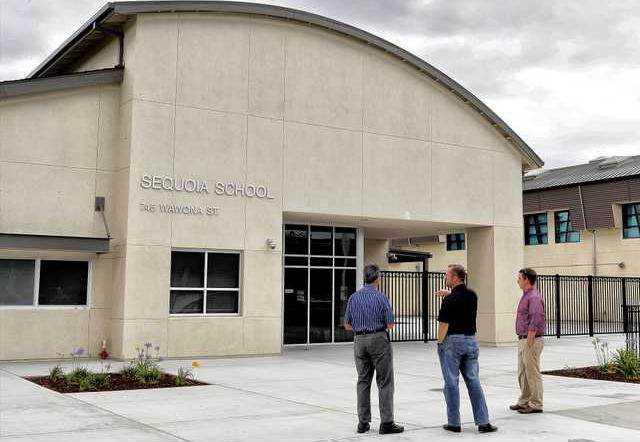There are 12 student restrooms at Sequoia School.
That is addition to four staff bathrooms.
It took custodians upwards of 30 minutes or so to clean each student restroom after the school day ends before Measure G work started.
Now that the bond work has been completed new concrete floors have allowed clean up time to be slashed by 10 minutes per restroom freeing up two hours of custodian time per day. That translates into 340 hours of labor saved in a school year. Over the course of 30 years — assuming a custodian’s salary and benefits are at the lower end of $15 per hour — the new bathroom upgrades will allow at least $153,000 in cost avoidance.
When applied to the first five schools modernized with Measure G funds, the district is on target to reduce labor costs for cleaning bathrooms by $765,000 in constant 2018 dollars between now and 2048.
What that realistically means is the custodian staff will have time freed up to address other campus needs including preventative maintenance that can reduce other costs.
“The maintenance of bathrooms was taken into consideration when we were putting together Measure G projects noted Superintendent Clark Burke.
The decision to go with brushed concrete floor instead of linoleum eliminated stripping and waxing plus made it easier to clean and sanitize the bathroom floors.
In some cases the bathroom issues were so bad — aging plumbing that clogged easily, issues with fixtures, and even bathroom wall tile — that restrooms were torn down to the dirt. Such was the case at one restroom at Golden West School.
Ventilation and light were maximized within each restroom’s perimeters based on their location.
As an example Golden West has a free-standing building with a set of bathrooms that made it possible to install louvre style ventilation along sink walls to take advantage of fresh air movement to address odor issues
In some cases, such as at Lincoln School, smaller “right-sized” toilets were added for the kindergarten classes.
Sequoia School also offers examples of other upgrade designs aimed at lengthening the life of facilities and reducing maintenance costs.
The cluster of eight new classrooms replacing eight portables that had fallen into severe disrepair has a split roof design featuring an angled roof on either side that allowed a gap in the middle to place heating and air conditioning units out of sight below the edge of the two roof lines.
The roofs then used Presidential composition style roofing with a rated life of 40 years. Not only is the life expectancy longer but since it uses composition roofing repairs, when needed, can be made without incurring major expense.
Standard linoleum flooring in classrooms that were modernized were replaced with Marmoleum that not only has a longer 40-year life put is easily repairable, hides scratches, and can be maintained with a damp mop to eliminate the need to strip and wax.
Large areas of asphalt that were not part of playgrounds were replaced with concrete to eliminate the need to keep repaving.
At the same time to address puddling and other issues, after areas were regraded to provide for run-off appropriate sections was left uncovered without concrete. Instead mulch was used and low water use and low maintenance shrubs were placed.
Clark noted that it is a design that dovetails well into the fact that all campuses contain storm water on site through percolation and the use of French drains.
Landscape architects selected shrubs and trees — working in concert with site principals — to create planters that would not be overgrown or pose a security risk by creating places people could hide as the homeless sometimes do when they sleep in bushes along the perimeter of Manteca High, are low maintenance, and enhance the looks of the campus.
One campus — Golden West School — even has a small patch of artificial turf in a small quad/walkway area.
Manteca Unified Director II of Facilities and Operations Aaron Bowers said it is being tested at Golden West to see if it works well in small areas that are heavily traveled in a bid to reduce mowing costs.
The location at Golden West School is a significant distance from other grassy areas and would require a smaller mower if it were planted in grass.
Specific changes
at Sequoia School
The $7 million worth of work at Sequoia School included re-orientating the campus to Wawona Street to eliminate congestion and safety uses at the original Martha Street entrance.
The new office facing Wawona Street gives the office staff a clear view of those entering and leaving the campus. The Martha Street entrance has been converted into a drop-off area for kindergarten students. A self-locking gate also allows teachers access to a parking area.
The Measure M improvements were designed to dovetail into the multiple purpose room that serves as a cafeteria and gym that was built with the last decade as well as the solar panels that do double duty as parking shade structures.
To contact Dennis Wyatt, email dwyatt@mantecabulletin.com





